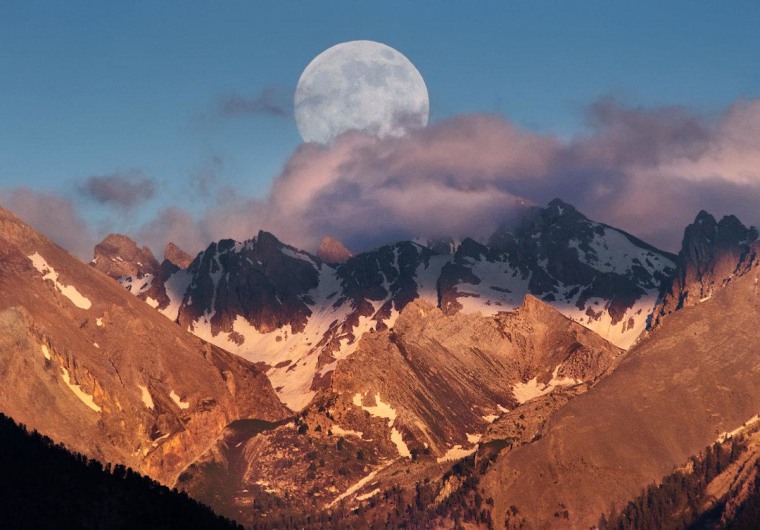
This year's supermoon has hit its peak, but the show isn't over yet.
This is the weekend to see the biggest, brightest full moon of the year, thanks to two lunar phenomena that came together on Sunday morning: The moon reached the closest point in its elliptical orbit around our planet at 7 a.m. ET, and it hit the peak of its full phase a little more than a half-hour later. As a result, the moon looked 14 percent wider than its minimum apparent size, and shone 30 percent brighter than its dimmest glow. For folks who don't keep close track of the moon, the difference might be hard to notice. But in any case, it's a good excuse to look up and enjoy some lunar loveliness. And take some pictures.
So far, we've received more than 150 photos of the full moon — framed by mountains and forests, cityscapes and clouds. One of the choicest shots shows the moon rising from a moody bank of clouds in the French Alps. Photographer Mike Long told NBC News that he snapped the picture from his home's third-floor balcony. "It was one of those moments where, after 30 years of photography, everything just comes together, and it's a nice surprise," he said. "That's what keeps you going as a photographer."
Because of the full moon's timing, the viewing on Sunday evening should be just as good as it was on Saturday evening. There's nothing to fear: Some folks have claimed that a supermoon could cause catastrophes like the 2011 earthquake and tsunami in Japan, but that's simply not the case. The best-known physical effect of a super-close moon has to do with the tides. During the lunar full phase and new phase, the Earth, moon and sun are lined up in a way that amplifies the gravitational pull on ocean waters. When the moon is closest to Earth during its full or new phase, that creates what's called a "perigean spring tide." Such a tide may rank as the year's strongest tide, popularly known as the king tide. For many coastal locations, this year's king tide occurs on Sunday night or Monday. Check out this interactive map for a rundown of king tides on the Atlantic coast — and consult this webpage to learn more about tidal phenomena, including tidal lag.
Even if the clouds obscure the moon in your locale, you can still catch sight of the supermoon online, thanks to Slooh Space Camera's webcast. The show gets started at 9 p.m. ET Sunday, and will feature imagery from a telescope in the Canary Islands as well as expert commentary. You can also tune in the show on Slooh's iPad app.
Check out this selection of supermoon views from photographers around the world. Thanks to everyone who's been sharing their shots, even if we couldn't get them in the gallery. These photos have been provided by users and have not been verified by NBC News.
More about the supermoon:
- Slideshow: Top shots from 2013's supermoon
- Supermoon hits prime time around the world
- NBC News archive on the supermoon
Alan Boyle is NBCNews.com's science editor. Connect with the Cosmic Log community by "liking" the NBC News Science Facebook page, following @b0yle on Twitter and adding the Cosmic Log page to your Google+ presence. To keep up with NBCNews.com's stories about science and space, sign up for the Tech & Science newsletter, delivered to your email in-box every weekday. You can also check out "The Case for Pluto," my book about the controversial dwarf planet and the search for new worlds.